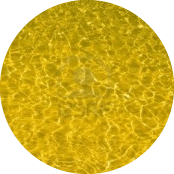
Limits for drinking water: 20 mg/l (ppm) Pt
- Various colors of water (orange, brown, green)
- reduces the effectiveness of UV disinfection, signals another water pollution
Water cleaning
- Solution principle – coagulation, adsorption, special ion exchangers, reverse osmosis
Water color may be caused by many various agents. In the nature, coloring is most often caused by matter from plants, mostly humic acids (the color is yellow or yellow-brown). These can be removed by coagulation (precipitation) or adsorption on activated carbon.
Another source of water color can be human waste. Whether it is outright dyes (e.g. from textile or food industry) or wastes of a different kind. Their chemical properties may vary greatly and to find a suitable method of disposal requires preliminary tests (laboratory or pilot plant). In this case, however, coagulation and adsorption on activated carbon are most often chosen.
There is also the seeming color of water. This is caused by undissolved substances and can be removed by filtration. Green coloration is caused by phytoplankton (microscopic plants living in water), orange or yellow coloration is caused by corrosion products (rust).

